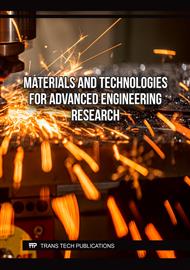[1]
D.R. Noakes, A.S. Arrott, M.G. Belk, S.C. Deevi, Q.Z. Huang, J.W. Lynn, R.D. Shull, D. Wu, Incommensurate spin density waves in iron aluminides, Physical Review Letters. 91 (2003) 217201.
DOI: 10.1103/physrevlett.91.217201
Google Scholar
[2]
A. Manchon, N. Ryzhanova, A. Vedyayev, B. Dieny, Spin-dependent diffraction at ferromagnetic/spin spiral interface, Journal of Applied Physics. 103(2008) 07A721.
DOI: 10.1063/1.2837479
Google Scholar
[3]
M. Krasnowski, T. Kulik, Nanocrystalline FeAl intermetallic produced by mechanical alloying followed by hot-pressing consolidation, Intermetallics. 15 (2007) 201-205 .
DOI: 10.1016/j.intermet.2006.05.008
Google Scholar
[4]
M. Krasnowski, A. Grabias, T. Kulik, Phase transformations during mechanical alloying of Fe–50% Al and subsequent heating of the milling product, Journal of Alloys and Compounds. 424 (2006) 119-127.
DOI: 10.1016/j.jallcom.2005.12.077
Google Scholar
[5]
R.N. Nogueira, C.G. Schön, Embedded atom method study of the interactions between point defects in iron aluminides: Double defects, Intermetallics.13 (2005) 1233-1244.
DOI: 10.1016/j.intermet.2005.04.007
Google Scholar
[6]
D.G. Morris, The stress anomaly in FeAl–Fe3Al alloys, Intermetallics. 13.12(2005) 1255-1342.
DOI: 10.1016/j.intermet.2004.08.012
Google Scholar
[7]
Q. Zeng, I. Baker, Magnetic properties and thermal ordering of mechanically alloyed Fe-40 at% Al, Intermetallics.14 (2006) 396-405.
DOI: 10.1016/j.intermet.2005.07.005
Google Scholar
[8]
C.T. Liu, E.P. George, P.J. Maziasz, J.H. Schneibel, Recent advances in B2 iron aluminide alloys: deformation, fracture and alloy design, Materials Science and Engineering. A 258 (1998) 84-98.
DOI: 10.1016/s0921-5093(98)00921-6
Google Scholar
[9]
O. Kubashevsky, Metallurgija. Moscow, 1985.
Google Scholar
[10]
T. B. Massalski, J. L. Murray, L. H. Bennett, H. Baker, American Society for Metals. 1986.
Google Scholar
[11]
Y. X. Liu, F. C. Yin, J. X. Hu, L. I. Zhi, S. H. Cheng, Phase equilibria of Al-Fe-Sn ternary system, Transactions of Nonferrous Metals Society of China. 28. 2 (2018) 282-289 .
DOI: 10.1016/s1003-6326(18)64661-8
Google Scholar
[12]
V. Raghavan, Al-Fe-Mn (aluminum-iron-manganese), Journal of Phase Equilibria and Diffusion, 28. 4 (2007) 371-373 .
DOI: 10.1007/s11669-007-9096-8
Google Scholar
[13]
R. Brajpuriya, P. Sharm, S. Jani, S. Kaimal, T. Shripathi, N. Lakshmi, K. Venugopalan, Correlation between microstructure, magnetic and electronic properties of Fe1− xAlx (0.2≤ x≤ 0.6) alloys produced by arc melting, Applied surface science. 257.1 (2010) 10-16.
DOI: 10.1016/j.apsusc.2010.06.008
Google Scholar
[14]
B.K. Kuanr, M. Buchmeier, D.E. Buergler, P. Gruenberg, Exchange coupling of molecular-beam-epitaxy-grown Fe/Al/Fe trilayers by dynamic techniques, Journal of applied physics. 91.10 (2002) 7209-7211.
DOI: 10.1063/1.1448803
Google Scholar
[15]
F. Hadef, Solid-state reactions during mechanical alloying of ternary Fe-Al-X (X=Ni, Mn, Cu, Ti, Cr, B, Si) systems: A review, Journal of Magnetism and Magnetic Materials. 419 (2016) 105-118.
DOI: 10.1016/j.jmmm.2016.06.021
Google Scholar
[16]
O. Ikeda, I. Ohnuma, R. Kainuma, K. Ishida, Phase equilibria and stability of ordered BCC phases in the Fe-rich portion of the Fe–Al system, Intermetallics. 9.9 (2001) 755-761 .
DOI: 10.1016/s0966-9795(01)00058-9
Google Scholar
[17]
C.G. Schön, G. Inden, L.T.F. Eleno, Comparison between Monte Carlo and Cluster Variation method calculations in the BCC Fe–Al system including tetrahedron interactions, International Journal of Materials Research. 95.6 (2022) 459-463 .
DOI: 10.1515/ijmr-2004-0094
Google Scholar
[18]
B. Sundman, I. Ohnuma, N. Dupin, U. R. Kattner, S. G. Fries, An assessment of the entire Al–Fe system including D03 ordering, Acta Materialia. 57 (2009) 2896–2908.
DOI: 10.1016/j.actamat.2009.02.046
Google Scholar
[19]
S.L. Shang, H. Sun, B. Pan, Y. Wang, A.M. Krajewski, M. Banu, Z.K. Liu, Forming mechanism of equilibrium and non-equilibrium metallurgical phases in dissimilar aluminum/steel (Al–Fe) joints, Scientific reports. 11.1 (2021) 24251.
DOI: 10.1038/s41598-021-03578-0
Google Scholar
[20]
M.W. Safeen, P. Russo Spena, Main issues in quality of friction stir welding joints of aluminum alloy and steel sheets, Metals (Basel). 9 (2019) 610 .
DOI: 10.3390/met9050610
Google Scholar
[21]
S.A. Hussein, A.S.M. Tahir, A.B. Hadzley, Characteristics of aluminum-to-steel joint made by friction stir welding: A review, Materials Today Communications. 5 (20154) 32-49.
DOI: 10.1016/j.mtcomm.2015.09.004
Google Scholar
[22]
M.V. Matyunina, V.V. Sokolovskiy, M.A. Zagrebin, O.O. Pavlukhina, V.D. Buchelnikov, Phase Diagram of Fе-Al Alloys: A Study from First Principles, Bulletin of the Russian Academy of Sciences: Physics. 83 (2019). 844-846.
DOI: 10.3103/s1062873819070268
Google Scholar
[23]
M.E Matsnev, V.S. Rusakov , Mossbauer spectroscopy in materials science-2012: proceedings of the international conference MSMS-12. Olomouc, Czech Republic,11–15 June, 2012.
Google Scholar
[24]
R. N Wang, Y.He, J. Y.Feng, Explanation of the enhancement of NiSi thermal stability according to TFD equations and Miedema's model. Nuclear Instruments and Methods in Physics Research Section B: Beam Interactions with Materials and Atoms. 222(2004) 462-468.
DOI: 10.1016/j.nimb.2004.02.023
Google Scholar
[25]
A.K. Alsaedi, F.S. Abbas, A.S. Alaboodi, A.A. Abojassim, Estimation of thermodynamic parameters of Ni-Si base alloys using the semi-empirical Miedema model, Malaysian Journal of Science. 41 (2022) 22-27.
DOI: 10.22452/mjs.vol41no3.3
Google Scholar
[26]
R. F. Zhang, S. H. Zhang, Z. J. He, J. Jing, S. H. Sheng, Miedema Calculator: A thermodynamic platform for predicting formation enthalpies of alloys within framework of Miedema's Theory, Computer Physics Communications. 209(2016) 58-69.
DOI: 10.1016/j.cpc.2016.08.013
Google Scholar
[27]
H. Li, X. Sun, S. Zhang, Calculation of thermodynamic properties of Cu-Ce binary alloy and precipitation behavior of Cu6Ce phase, Materials transactions. 55(2014), 1816-1819.
DOI: 10.2320/matertrans.m2014319
Google Scholar
[28]
Aaronson, Hubert I., Masato Enomoto, Jong K. Lee, Mechanisms of diffusional phase transformations in metals and alloys. CRC Press, 2016.
DOI: 10.1201/b15829
Google Scholar
[29]
J.R. Callister., D.William, D.G. Rethwisch, Fundamentals of materials science and engineering: an integrated approach, John Wiley & Sons, 2020.
Google Scholar
[30]
E.V. Voronina, A.K. AlSaedi, A.G. Ivanova, A.K. Arzhnikov, E.N. Dulov, Structural and phase transformations occurring during preparation of ordered ternary Fe–Al–M alloys (with M= Ga, B, V, and Mn) by mechanical alloying, Physics of Metals and Metallography. 120 (2019) 1213-1220.
DOI: 10.1134/s0031918x19120172
Google Scholar


